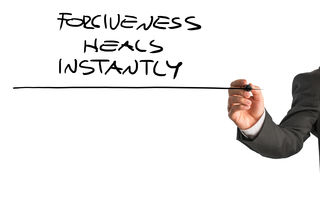Ongoing anger is an absolute block to moving forward and living a truly enjoyable life. You are stuck to past. As anger is a reflection of higher elevations of stress hormones, sustained levels of them will also make you sick. The list of stress-related diseases is long and they are serious. The essence of healing from mental or physical pain is learning methods to optimize your body’s chemistry to that of a play profile. There is a profound effect on every cell in your body (50 trillion of them). This occurs in the presence of deep compassion.
There are several factors to consider with regards to forgiveness:
- It is not an intellectual exercise. You have to be able to feel and acknowledge the depth of your anger before you can let go.
- You will always possess anger. You are not going to get rid of it. It is a survival reaction. Forgiveness is an ongoing daily practice.
- It is critical to become aware of and let go of your deepest wounds. Forgiving smaller wrongs is helpful, but is not going to really alter your body’s chemistry. Global ongoing anger is deadly.
- The final step of forgiveness is generating deep compassion for the person or situation that hurt you. You might be thinking at this moment, “No way!!” It is not a matter of liking this person, but do you really want to continue to give control of your quality of life to who you rightly despise?
- Deep compassion will move your brain activity off of the pain circuits and create a wonderful chemical environment. Why would you not want to exist in this state?
- BTW, it is common, if not the rule, that people become addicted to their pain and being in the victim role. It is irrational and the biggest block to healing. If you are already reacting to these first few sentences, you are in this role. I know because I was one of those people for most of my life.
Empathy/ compassion
The Oxford dictionary defines empathy as, “the ability to understand and share the feelings of another.” It is a core component of nurturing human relationships. If you don’t have some sense of how someone close to you is feeling, you can’t interact with them in a meaningful way. You might as well be in another room. The capacity to feel empathy is an inherent part of the human experience because from an evolutionary perspective, it was the species of humans who learned to cooperate that had the highest likelihood of survival.

Compassion is the next step in healthy relationships that follows empathy. You first have to have the ability to see a situation through the other person’s eyes with an understanding of what it might be like to be in a similar circumstance. Compassion is a desire to help out. Nurturing compassion has two parts: 1) engaging in practices that engender empathy, and 2) removal of any interference connecting you with your own compassion.
The disconnect–anger
The problem is that when you are consumed with frustration and anger, it is only about you and it is not possible to be aware of other’s needs. So, the foundational step of empathy is compromised. You might feel you have empathy in spite of being upset. You might–after you calm down. But often people in pain are constantly frustrated and many of their relationships are based on bonding with other people who are angry. It seems like a close relationship with intimate conversations around suffering. But do you really know the person beneath the pain? It is a vicious cycle and one of the reasons why it is so important to never discuss your pain or medical care with anyone except your providers – ever!!
We all have a deep need to help those around us. But when you are angry, compassion goes right out the window. It is the interference that needs to be dealt with before you can feel compassion and engage in helpful acts. Only then are you able to implement practices to increase your empathy–starting with awareness.
Brenda
Patients freed of pain often want to give back—and in a big way. Brenda was a patient who became paraplegic from an unfortunate series of events surrounding spine surgery. She wasn’t happy before the complication occurred and certainly not after it. Using the methods she learned in the book, Forgive for Good (1) made a tremendous impact on her outlook, mood, and pain.
After she embraced true forgiveness, her overwhelming urge was to help others in wheelchairs who were suffering from chronic pain. She was happier in a wheelchair than she was walking, anxious, and angry. She then descended back into her Abyss of chronic pain for several years. I recently heard from her, and she had pulled herself back out. Once you’ve tasted true freedom, you’ll know how to return to it.
Nurturing Compassion
I have a few suggestions to consider, which might help you formulate your own ideas of how to give back.
- Remain committed to your own journey. You can’t help others if you are not doing well.
- Practice awareness. Remain aware of yours and others’ needs, listen carefully to others and try to see situations through their eyes.
- Don’t discuss your pain, complain, give unasked-for advice or be critical. None of these are compassionate acts. It is a little harder than you might think, because all of us complain. It really isn’t that enjoyable.
- Learn a compassion-based meditation practice. I don’t meditate easily and I have condensed my practice to, “be nice” regardless of the situation. It is humbling to see how difficult this is.
- Your highest priority is your immediate family. Even if you’re in pain, always treat them well.
It seems almost impossible to forgive those you have wronged you or commit evil deeds. It is indeed extremely challenging. The first step is to realize how much suffering they are experiencing that drives them to act so badly. They are living in a dark world and may not have ever known love or what it even looks like.
Also remember that you don’t have to like the person who has committed bad deeds. That is a much different energy than letting go and having compassion.
Anger will block compassion. It has to be processed first. There is no way around it. The way you can and will nurture compassion for you, is to develop it towards others around you. It is the step beyond forgiveness.
Moving Forward
A growing body of research is showing that most people won’t let go of the situation or person who wronged them. (2) Hanging on to resentment has been shown to increase pain and compromise one’s quality of life. (3) Forgiveness is correlated with less mental distress, pain, and an increased capacity to enjoy life. (4)

Make a random list of ideas of ways to give back that are interesting to you–write them down. They can be small actions.
- Pick the top five
- Prioritize them.
- Pick one.
- Develop a focused plan.
- Do it!
What is your vision of what you’d like your life to look like in one year/ five years?
- Be as detailed as possible.
- Learn organizational skills to implement your vision.
- Getting Things Done (5) by David Allen is an excellent resource.
Creating your vision and moving forward with or without your pain requires compassion and a commitment to yourself. It is the surest way to leave your pain behind as you actively re-engage with an enjoyable life. It is your time to thrive!!
References
1. Luskin, Fred. Forgive for Good. Harper Collins, New York, NY. 2002.
2. Burns JW: Anger management style and hostility: Predicting symptom-specific physiological reactivity among chronic low back pain patients. J Behav Med (1997); 20:505-522.
3. Burns JW, Johnson BJ, Devine J, Mahoney N, Prawl R. Anger management style and the prediction of treatment outcome among male and female chronic pain patients. Behav Res Ther (1998)l 36:1051-1062.
4. Carson, JW, et al. Forgiveness and Chronic Low Back Pain: A Preliminary Study Examining the Relationship of Forgiveness to Pain, Anger, and Psychological Distress. The Journal of Pain (2005); 6: pp 84-91.
5. Allen, David. Getting Things Done. Penguin Books, New York, NY, 2015.
